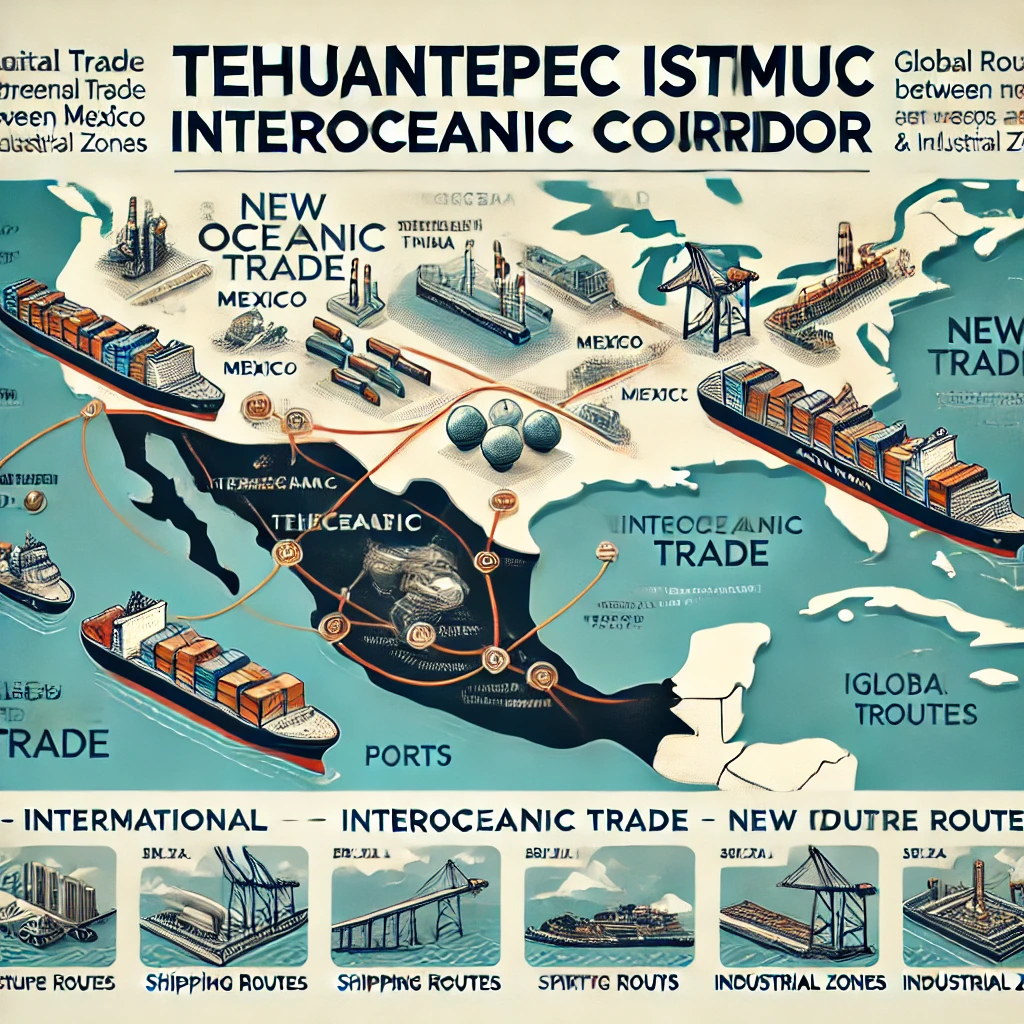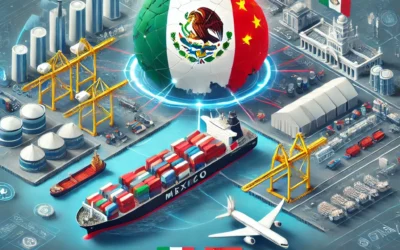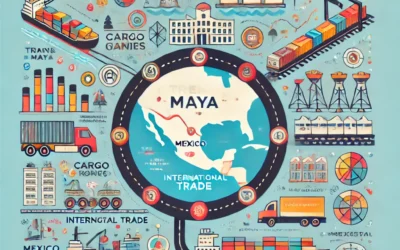The Tehuantepec Isthmus Interoceanic Corridor (CIIT) is a strategic infrastructure project aimed at transforming southern Mexico into a major logistics hub by connecting the Pacific and Atlantic Oceans. With significant investments in rail, port, and industrial facilities, the corridor offers an alternative to the Panama Canal. For Chinese companies, this project provides a new and efficient trade route to optimize operations in North, Central, and South America.
Overview of the Tehuantepec Isthmus Interoceanic Corridor
- Geographical Advantage: The CIIT spans approximately 300 kilometers, linking the port of Coatzacoalcos on the Gulf of Mexico with the port of Salina Cruz on the Pacific. This route creates a faster, more cost-effective option for transporting goods between the oceans, particularly for companies looking to bypass the congestion and high fees associated with the Panama Canal.
Example: Reduction in Transit Times and Costs
The CIIT significantly reduces transportation times and operational costs for companies moving goods between Asia and the Americas. For Chinese companies, this presents a unique opportunity to establish a more efficient route for both imports and exports.
- Logistics and Industrial Development: The corridor includes the development of industrial parks and logistical centers along the route, providing Chinese companies with modern infrastructure and strategic locations to establish distribution centers, manufacturing plants, and storage facilities.
Example: Special Economic Zones (SEZs)
Mexico is developing Special Economic Zones along the CIIT, offering tax incentives, reduced tariffs, and streamlined customs processes. Chinese companies can leverage these zones to manufacture, store, and distribute products throughout the Americas.
Strategic Importance for Chinese Companies
- Enhanced Trade Routes: The Tehuantepec corridor offers Chinese companies direct access to the Americas, enabling smoother and faster movement of goods. By utilizing the corridor, companies can reduce dependency on longer, more expensive routes and increase competitiveness in the global market.
Example: Exporting Electronics and Consumer Goods
Chinese manufacturers of electronics, machinery, and consumer goods can use the CIIT to ship products efficiently across the Americas. This reduces shipping times to key markets in North and South America, including the U.S. and Brazil.
- Energy and Resource Logistics: With its proximity to the Dos Bocas Refinery and other energy projects, the corridor also serves as a strategic location for the transportation of energy resources. Chinese companies involved in the oil, gas, and renewable energy sectors can take advantage of the corridor to transport fuels and materials more effectively.
Connection with Other Infrastructure Projects
- Integration with the Tren Maya: The Tehuantepec corridor is strategically linked to other large-scale infrastructure projects in Mexico, such as the Tren Maya, which enhances connectivity across southern Mexico. This integration creates a comprehensive logistics network that allows Chinese companies to move goods seamlessly from the industrial zones of the Isthmus to other key regions in the country.
- Ports and Shipping: The modernization of the ports of Coatzacoalcos and Salina Cruz enhances Mexico’s capacity to handle larger volumes of cargo, particularly bulk goods and container shipments. This is a significant advantage for Chinese companies looking to streamline their global supply chains.
Example: Shipping Efficiency
The enhanced port facilities along the CIIT offer faster turnaround times and improved handling of bulk shipments. This is especially important for companies in sectors such as manufacturing, technology, and energy.

Opportunities for Investment in the CIIT
-
Infrastructure Development: Chinese companies specializing in infrastructure, engineering, and construction can participate in the continued development of the corridor’s logistics and industrial facilities. This includes building new warehouses, rail lines, and distribution hubs along the route.
Example: Partnerships in Infrastructure
Chinese firms have already demonstrated their ability to undertake large-scale infrastructure projects globally. By partnering with Mexican developers, these companies can contribute to the construction of the CIIT and its associated facilities.
-
Manufacturing and Distribution: The CIIT presents opportunities for Chinese manufacturers to establish production facilities in Mexico, leveraging the country’s proximity to the U.S. and Canada through the T-MEC agreement. Products manufactured in Mexico can be exported to North American markets with reduced tariffs and faster delivery times.
Example: Nearshoring for Chinese Companies
As nearshoring becomes a growing trend, Chinese companies can capitalize on Mexico’s location to produce goods closer to key markets. This reduces shipping times, minimizes costs, and improves supply chain reliability.
Benefits of the Tehuantepec Corridor for Chinese Companies
-
Increased Competitiveness: By reducing transportation costs and improving access to key markets, the CIIT enables Chinese companies to increase their global competitiveness. Faster shipping times and lower logistics costs allow companies to respond more quickly to market demand and gain a strategic advantage in the Americas.
-
Government Incentives and Support: The Mexican government offers a range of incentives for companies investing in the CIIT, including tax breaks, reduced tariffs, and streamlined regulatory processes. These incentives are designed to attract foreign investment and encourage the development of industries along the corridor.
Example: Tax Incentives for Industrial Zones
Companies that establish operations in the SEZs along the CIIT can benefit from reduced corporate taxes, lower import and export duties, and access to skilled labor. This makes Mexico an attractive destination for Chinese companies looking to expand their operations.
-
Improved Connectivity: The corridor improves connectivity not only within Mexico but also with key global markets. By establishing operations in Mexico, Chinese companies can access North America, Latin America, and Europe more efficiently, reducing the need for complex and costly shipping routes.
How Gladium Pacific Can Help
-
Consulting on Infrastructure and Logistics: Gladium Pacific provides strategic advice to Chinese companies looking to invest in the CIIT. We assist with identifying key projects, establishing partnerships with local developers, and navigating Mexico’s regulatory framework.
-
Supply Chain Optimization: Gladium Pacific helps Chinese companies optimize their supply chains by leveraging the CIIT’s infrastructure. This includes identifying the most efficient shipping routes, reducing operational costs, and improving delivery times to key markets.
-
Regulatory Compliance and Project Management: Our team ensures that Chinese companies comply with local regulations and manage risks associated with infrastructure and logistics projects in Mexico, enabling smooth and successful investments.
Recent Developments in Mexico’s Trade and Infrastructure
-
Increase in Foreign Direct Investment: Mexico attracted more than $35 billion in FDI in 2023, much of it directed toward infrastructure and logistics projects, including the CIIT.
-
Trade Growth with China: Trade between Mexico and China has increased by over 40% in the past five years, driven by growing demand for Chinese goods in Latin America and Mexican exports to Asia.
Key Statistics
-
Freight Capacity: The CIIT is expected to handle up to 10 million tons of cargo annually, positioning Mexico as a major logistics hub in the Americas.
-
Infrastructure Investment: Mexico has invested over $5 billion in the CIIT, with plans to attract even more foreign investment to expand its capabilities.
Conclusion
The Tehuantepec Isthmus Interoceanic Corridor presents a strategic opportunity for Chinese companies looking to enhance their operations in the Americas. With faster shipping routes, modern infrastructure, and government incentives, the corridor is set to become a key player in global trade. Gladium Pacific is ready to help Chinese companies navigate these opportunities and ensure successful investments in Mexico’s logistics and infrastructure sectors.









